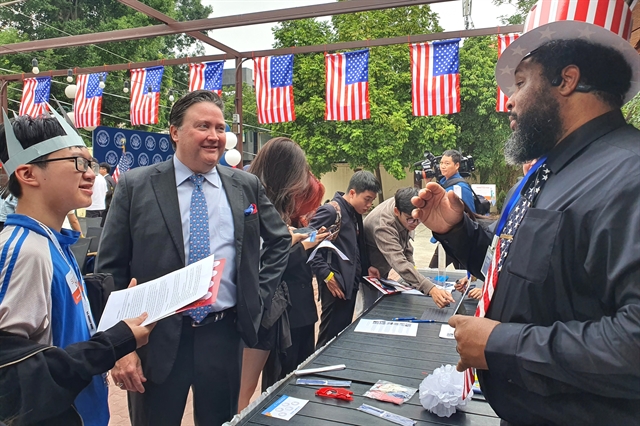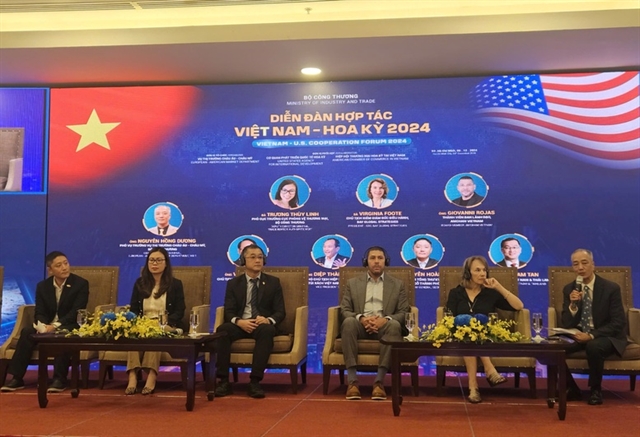 Politics & Law
Politics & Law

 |
| Speakers at the Việt Nam – US Cooperation Forum 2024 on Friday in HCM City. — VNA/VNS Photo |
HCM CITY — Việt Nam has become a major partner for the US government and businesses, serving as a key player in global supply chains due to its “entrepreneurial workforce, strategic location, and a dynamic network of trade ties,” said a US diplomat.
Speaking at the Việt Nam – US Cooperation Forum 2024 on Friday, Anne Benjaminson, acting consul general at the US Consulate General in HCM City, said that the economic relationship between the two nations is “strong, forward-looking, and positive.”
“Our supply chain linkages with Việt Nam are not a one-way street – for example, Việt Nam imports American-made semiconductors, which are tested and packaged here in factories across Việt Nam.
“These linkages demonstrate just how interconnected our two economies have become and how important bilateral trade is for global supply chain resiliency and our collective prosperity.
“We both realise that trade must go both ways, and we invest in each other’s economies as we purchase each other’s goods.
“Supply chains can’t be resilient if they are not sustainable. That is why we are working across the US Mission to accelerate Việt Nam’s clean energy transition," she said.
The US is partnering with Việt Nam to enhance energy planning, attract private investment in clean energy, and fund feasibility studies for expanding electricity infrastructure and battery storage technologies, according to Benjaminson.
Eugene Laney, president and CEO of the American Association of Exporters and Importers (AAEI), said over the past five years Việt Nam has emerged as an appealing destination for American businesses, driven by the expansion of its middle class, increasing income levels, and evolving consumer preferences.
“Việt Nam has been recognised as a viable alternative sourcing and selling base for US companies,” he said. “With a population approaching 100 million, the nation presents a substantial consumer base for US enterprises to engage with.”
Tạ Hoàng Linh, director of the European-American Market Department at the Ministry of Industry and Trade, said Việt Nam is now the eighth-largest trading partner and the fourth-largest export market for the US within the ASEAN region.
Meanwhile, the US stands as Việt Nam’s second-largest trading partner and primary export market, he added.
Juan Pablo Feregrino of the US Agency for International Development (USAID) said the Việt Nam-US relationship is experiencing significant growth across various sectors.
Both public and private entities in the US are keen to enhance collaboration with Việt Nam in areas aligned with current sustainable development trends, such as digital economy, e-commerce, energy, healthcare, education, and financial services, he added.
Challenges
While the opportunities are promising, Benjaminson also acknowledged ongoing challenges in the business environment in Việt Nam.
“We are concerned about widespread bureaucratic delays and insufficient progress in the clean energy transition, which could threaten Việt Nam’s security, sustainability, and ability to attract foreign direct investment,” she said.
According to data from the US Census Bureau, as of October, Việt Nam is the US’s eighth largest trading partner, with a total trade turnover of $123.2 billion, up 19.3 per cent from 2023.
Exports to the US reached $112.7 billion, while imports were $10.5 billion, a 29.4 per cent increase from the previous year.
Việt Nam’s trade surplus with the US is $102.2 billion, the third largest after China and Mexico.
According to data from Vietnamese Customs, as of October 2024, bilateral trade surpassed $111 billion, a 22.5 per cent year-on-year increase.
Việt Nam exported $98.7 billion to the US (up 24.6 per cent) and imported $12.2 billion (up 7.9 per cent), resulting in a trade surplus of $86.5 billion.
The forum was organised by the Ministry of Industry and Trade in collaboration with the US Embassy and the American Chamber of Commerce in Việt Nam.
It was attended by over 350 delegates from Vietnamese authorities and the manufacturing sector. — VNS




